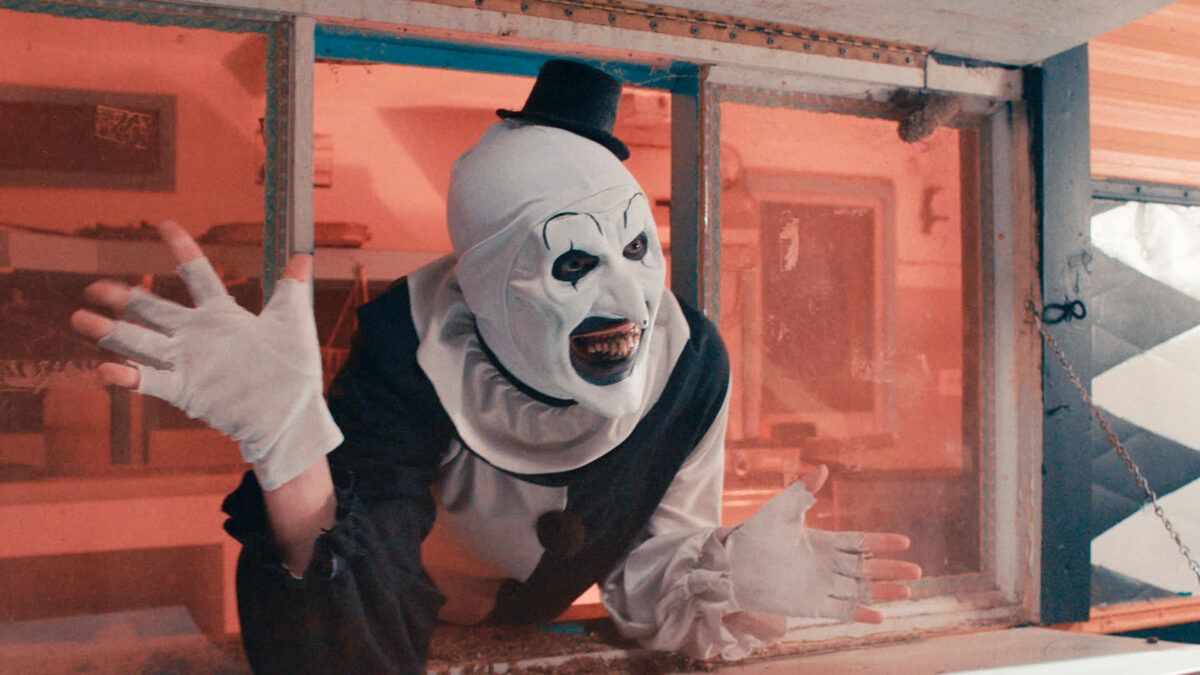Do you want the Terrifier 2 ending explained? This article contains everything you need. I discuss the important themes associated with grief and trauma, what Art the Clown symbolically represents, and what the post-credits scene signifies for Terrifier 3.
What is Terrifier 2 about?
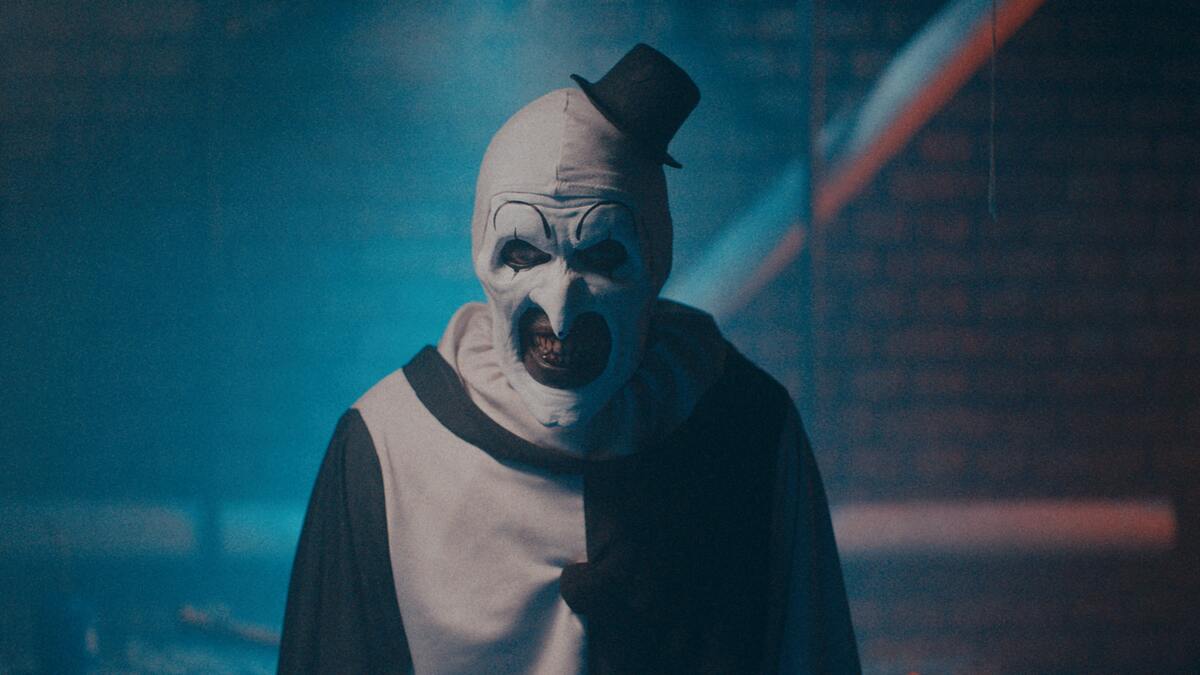
Terrifier 2 is all about how terror can grip an individual, can haunt a community. Art the clown is true to his name, as art gives us the ability to explore our deepest fears and anxieties through images, words, sounds, and stories. He is the embodiment of evil, and he haunts the residents of Miles County as they cope with a tragedy. After a bloody massacre that took ten lives, Art’s mysterious presence haunts the community as people obsess over his whereabouts and fear his return—in artistic terms, he’s the cookie-cutter definition of a symbol. And as his terror pervades Miles County, the embodiment of goodness is required to fight him.
That’s where Sienna comes in. Grappling with her own tragedy in the loss of her father, she must realize a destiny her father foresaw: Sienna must vanquish Art. Thus, Art’s communal terror then extends to Sienna’s individual journey. She and her brother Jonathan are desperate to make sense of their father’s mental deterioration, to understand why he became abusive at the end of his life. As Sienna fights Art, she’s symbolically battling the inner grief and trauma that has gripped her family since their father’s death. As Sienna fights the evil that has a stranglehold over her community, she’s fighting for both her community’s and her own survival.
Terrifier 2 ending explained
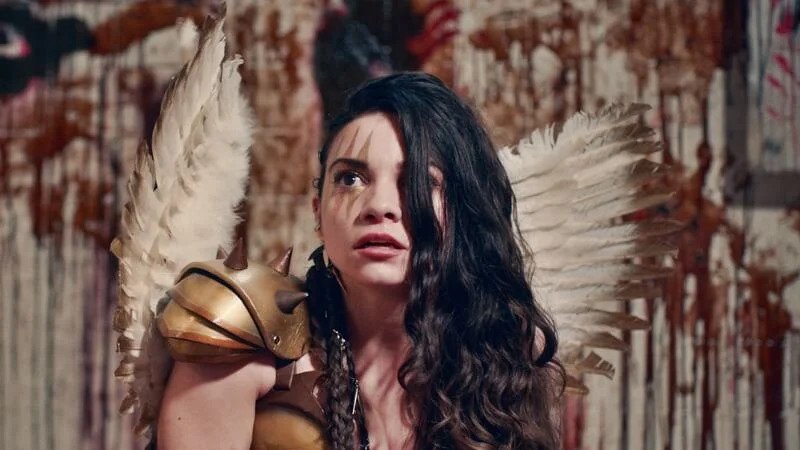
There are several areas to address with the ending of Terrifier 2. First, what exactly happened and the mythology behind it. Second, the deeper thematic reasons for what happened. And finally, what the mid-credits scene signals about the return of Art the Clown.
A recap of Terrifier 2‘s ending
I think a quick recap is first in order, as several of these details will be important in our analysis.
Sienna, wearing her Valkyrie Halloween costume, has a full-on panic attack when she spots The Little Pale Girl at the party. She screams and hyperventilates to the point where her friend Brooke and Jeff (Brooke’s boyfriend) decide to drive her home. Then, a chilling call from The Little Pale Girl, who is mimicking her younger brother Jonathan’s voice, leads Sienna to an abandoned carnival and into the eerie corridors of a haunted house attraction known as The Terrifier. There, Art kills both Brooke and Jeff before moving on to Sienna and Jonathan.
After discovering Brooke’s lifeless corpse, Sienna engages in battle with Art until he knocks her unconscious. Art then turns his attention to Jonathan, whom he begins to torture with a scalpel. Sienna awakes and fends off Art with his own weapons. But even when Sienna and Jonathan believe they’ve killed Art, he comes back. Eventually, Art stabs Sienna with her own sword and tosses her into a water tank in a hellish chamber. As Art returns to torturing Jonathan, Sienna dies in the cell before being miraculously resurrected by the very sword that killed her.
Sienna then returns to save Jonathan by hacking away at Art with her sword. She chops and chops and chops before eventually decapitating this force of evil. But before long, the Little Pale Girl returns to take Art’s head and walk away. Sienna and Jonathan cry and watch in terror as their battle with Art comes to an end—for now.
Then, in the mid-credits scene, Victoria—Art’s victim from the first film whose face has been mutilated and later attacked a talk show host—throws up before writing “Vicky + Art” and obscenities on the wall of a psychiatric hospital with her blood. She then gives birth to Art’s devilishly smiling head.
The mythology and deeper meaning
In the commentary for Terrifier 2, director Damien Leone references the film’s “Biblical, mythic theme” several times. As he should, as it’s ever-present: between the sword and the Valkyrie costume, Sienna almost cartoonishly embodies a character destined to vanquish great evil. Those kinds of journeys are reserved for heroes from epic stories written long ago—not for high school girls from small towns. But Sienna is destined for something great. Her father knew it, and Jonathan believes in it, but Sienna herself must come to terms with her destiny at some point.
In an interview with Insider, Leone elaborated on the mythic imagery:
“I mean, there’s blatant religious mythic imagery, clear as day. There is a heaven and hell thing going on. And the clown is this resurrected demon and Sienna is slowly becoming aware that she’s sort of this Old Testament angel ready to do battle and going through that metamorphosis. That discovery was really what was the most exciting thing to me in this movie.”
Realizing she has such potential is essentially Sienna’s entire journey and what makes the ending so cathartic. She must believe in something greater than herself in order to transcend the ugly reality that plagues her: the crippling grief, the overwhelming trauma that has been her life. By accepting that sword, Sienna accepts that she must play her part of ridding the world of evil.
I love how Sienna’s destiny becomes such a mythologized presence in this world created by Leone. Specifically, the role her father plays in her realization, almost acting as a medium between the comfortable vision of our world and the ugly reality of evil that lurks beneath it. While we don’t see the father, his presence is undeniable—to the point where people theorize that Sienna’s father is actually Art the Clown. And they’re not wrong for thinking that, as we will discuss.
Leone goes into further detail about the father’s role in Terrifier 2‘s mythology in the director’s commentary:
The father was sort of a vessel for that supernatural good that needs to get to Sienna, and he was the one who started getting the visions; not understanding why necessarily or what’s happening, but he knew he had to get the sword for Sienna. He knew that she was meant for something important. And because of that, he was also channeling the bad force that was coming in; the evil entity that was gonna be the counterpart to that good…It was all starting to come through, and that’s why he was becoming abusive. And all of this going on inside of him manifested itself into a physical tumor that eventually made him go crazy and kill himself. He was the vessel. It was channeling through him, and he was supplying Sienna with what she needed to go forward on her journey. It was an essential sacrifice on his part.
So you see, it’s not necessarily that Sienna’s father is Art the Clown, but that her father represents the terror perpetuated by Art the Clown. In the real-world logic of Terrifier 2, Sienna’s father simply envisions this hellish entity that will wreak havoc on Miles County and knows that Sienna must be the one to vanquish it. These visions cause her father to lose his mind and embody the very evil he envisions, becoming mentally deranged and abusive. (I assume the insane clown café commercial from Sienna’s dream was the kind of vision her father was seeing.)
As we discussed in the themes section, the killer clown’s very name demonstrates the power art has to recreate universal truths and hazards of life. Art becomes a literal manifestation of Sienna’s grief, of her inability to move on from her father’s death. So, in a way, Art the Clown is her father—but perhaps only in the artistic sense. Art the Clown, in this way, becomes a symbolic presence like we’d see with any antagonistic character in any other mythological tale. He represents the ugly reality of our world, of the horrors we must face in everyday life.
That’s why the sword is such an important motif. The father creates the sword, and Jonathan knows that Sienna must wield it. But it takes an extreme realization, profound self-confrontation for Sienna to accept it. But once she does, her father’s sword heals her and allows her to save her brother. In this way, the father represents both good and evil—he is both Art the Clown and the goodness necessary to stop Art the Clown.
The mid-credits scene explained
There’s one part of the ending we haven’t addressed: the Little Pale Girl. And she will be our key to understanding the mid-credits scene.
Before we get into the logic and details of Art’s resurrection at the end of Terrifier 2, it’s important to recognize the Little Pale Girl’s symbolic presence. As discussed in the themes section, Art represents more than just grief for Sienna—he embodies how terror can grip an entire town. Again, Art stays true to his name here by becoming a real-world presence that the people of Miles County must reckon with. And Emily Crane, aka the Little Pale Girl, becomes that reckoning. Art took the life of a child—one of the most sacred sins one can commit. In this way, Sienna’s father’s sketchbook drawings were an attempt to save his own daughter, to equip her to battle this despicable presence in Miles County.
So it’s meaningful that the Little Pale Girl is the one to carry Art’s head away. While Sienna may have battled her own demons and defeated Art, the death of Emily Crane still lingers. Thus, the presence of Art’s destruction lingers, creating trauma that will continue to plague Miles County for generations. It can all be traced back to Emily Crane, who ensures Art’s terror will continue to grip the community by taking his head away and finding it a new home.
This is why Victoria, who was attacked and tortured by Art the Clown in Terrifier, gives birth to the next manifestation of such a villain. Leone himself said in the director’s commentary that Victoria is possessed by the Little Pale Girl in the mid-credits scene—un-immaculate conception, as he puts it. Victoria didn’t die from Art’s attacks, making her the perfect vessel through which his terror can continue. He becomes a parasite on two of his own victims—Victoria possessed by Emily Crane—and rebirths himself into a community where each of their pain endures.
The themes and meaning of Terrifier 2
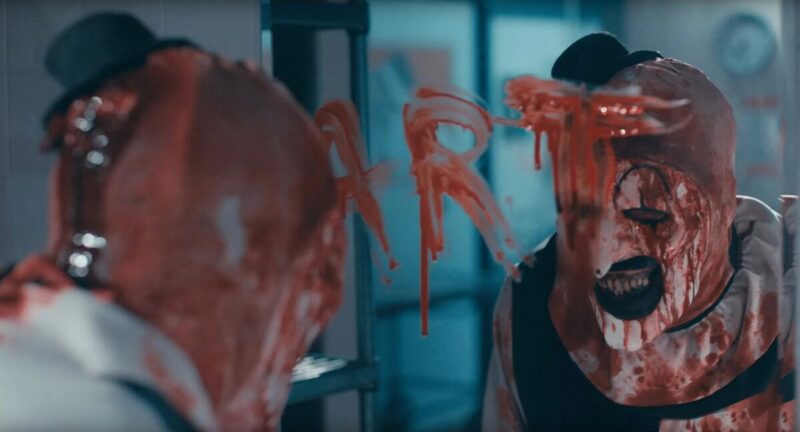
Overcoming trauma and grief
“Dealing with grief” is a common theme in so many horror movies because the genre is an inherently great vessel for it. Recently, you saw it in movies like Talk to Me and No One Will Save You. Basically, the presence of death and monsters and spirits allows filmmakers to thrust a character grieving the loss of someone headlong into the five stages of grief: denial, anger, bargaining, depression, acceptance. In a movie like Terrifier 2, we essentially see characters like Sienna and Jonathan going through this process. Maybe not in that exact order, and perhaps not in real time—but, effectively, we see them inching towards the “acceptance” portion of the process.
And the “acceptance” part is so cathartic in a horror movie. Because it’s not necessarily about overcoming the death of somebody you love but instead coming to terms with it. Someone like Sienna is forced to go through absolute hell in order to vanquish this entity that essentially serves as a constant reminder of her father. Jonathan saw the signs: he found the drawings and knew that his father believed Sienna to be the force of good that must destroy Art. But it took Sienna a long time to realize it herself. She wanted to deny that any of this could be real, that this hellish creation from her father’s nightmares could be a reality.
Art forces Sienna to confront many bad things. Like the fact that her father lost his mind, became abusive, became a shadow of his former self. She doesn’t want to confront this monstrous creature—but she must. Art is standing in the way of Sienna reckoning with her reality, with truly moving forward in the wake of her father’s death.
The power of art
This is my absolute favorite “theme” of Terrifier 2 that I’m not entirely sure was intentional, but has become my reason for believing Terrifier 2 is one of the best horror movies ever made. I love meta movies that make filmmaking part of the narrative—which we see in films like Perfect Blue and The Fabelmans—because they are actively acknowledging the relationship between art and artist. When done successfully, it provides such an intimate view of a movie’s deeper meaning and ideas. And Terrifier 2 took that very idea to a completely new level with Art the Clown.
Terrifier 2 presents a familiar feeling: one of inescapable anguish. The movie isn’t just an exploration of grief, but also of trauma, of regret, of dissatisfaction with your reality. Sienna and Jonathan aren’t just mourning the loss of their father—they’re consumed by it. They’re in disarray over their confusion, of what drove their father to take his own life. They desperately want to understand something outside of their control yet so close to their being.
That confusion then manifests in Art the Clown—a demon that haunted their father; a demon that is now tearing Sienna’s life apart as she searches for answers and meaning; a demon that, true to his name, exemplifies the very essence of art, that serves as a representation of inner struggle and turmoil, that compels everybody watching the movie to confront the hellish monster that roams the shadows of our everyday. Art announces his presence (and perhaps his thematic intent) when he writes his name on the mirror in blood at the beginning of the movie. He is the bloody, hellish, unforgiving manifestation of “art.” He will force people like Sienna, communities like Miles County to reckon with the evil that exists in our world, in worlds beyond our collective mortal understanding.
How terror can grip a community
There is a “2” in the title, as it is a sequel. That’s obvious enough. But it’s important to remember that Art has, prior to the events of Terrifier 2, terrorized other residents Miles County. He killed Emily Crane on Halloween, and then he killed a number of people in what’s known as the Miles County Massacre (these are the events of the first feature film, Terrifier). And his terror continues through the deaths of many others, such as the patron at the laundromat. Emily Crane then becomes the Little Pale Girl, a demon who resurrects Art after being he is killed at the Miles County Massacre.
With all this in mind, Art and the Little Pale Girl come to represent terror that continually grips a community. Individual people don’t just grieve. Entire communities grieve as well. The shock and horror from a single event can linger for years. In that sense, Emily Crane represents the embodiment of that ever-present anxiety. The death of a little girl is tragic. And a hellish force has overtaken Emily’s body to ensure that tragedy becomes a living, breathing entity that continues to haunt Miles County. Emily is the reminder of the specific event, and Art is the reality that evil exists. As Damien Leone continues to make Terrifier films, each successive entry will continue to build on that collective trauma.
You could argue that many horror franchises have treaded these paths. For instance, Michael Myers haunts Haddonfield, Illinois, and Jason Vorhees haunts Camp Crystal Lake. But Terrifier 2 seems much more fixated on the community itself than those franchises (which have both gone to space, mind you). I would compare Terrifier 2‘s thematic approach more with The Shining, which explores how violence and abuse creates generational trauma that continually infects our children and their children and their children. Evil like Art the Clown doesn’t just come and go—it lingers and haunts, causing death and destruction long after it’s gone. Even when you think you’ve killed Art…he always comes back.
Why is the movie called Terrifier 2?
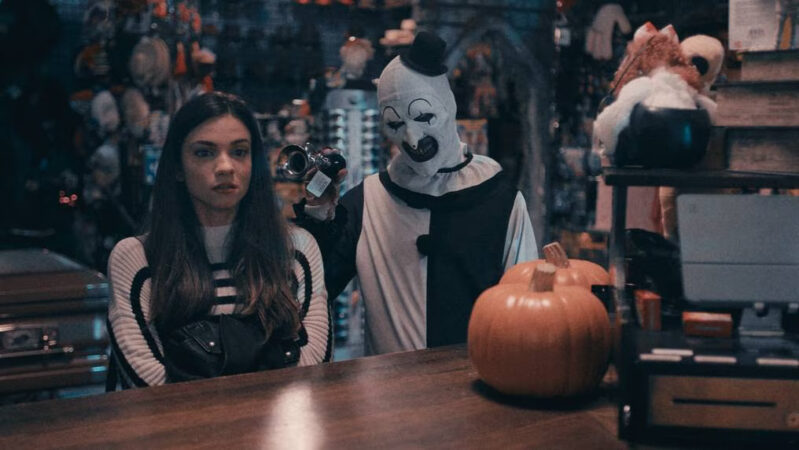
There are a number of reasons why the title “Terrifier” works so well. But on the director’s commentary track for Terrifier 2, Damien Leone explains how he originally came up with the name:
When I came up with that word for my short film Terrifier (released in 2011), I said I want this movie to feel like a rollercoaster—a horror-based rollercoaster that you get on and it just takes off and it never stops. And the name Terrifier came to me. So when I wrote the script for Terrifier 2, I knew it took place in this haunted house in the end, this funhouse, and I said, “I need a name for it.” And it was just a no-brainer. So not only will the name Terrifier be a sort of arbitrary name of this funhouse, but it will play a crucial role. It will be the structure that’s built upon the hell portal.
As Leone describes, the very title “Terrifier” carries an astounding, overbearing aura—like a rollercoaster. Once you’re on the rollercoaster, it won’t stop…you’re along for the ride whether you like it or not. And that energy properly describes the Terrifier franchise. Art the Clown absolutely relishes in torturing his victims, in dragging out their inevitable deaths. Once you aboard his rollercoaster, there’s no escaping.
This brings such energy to the word “terrify,” as Art becomes an overwhelming force. You aren’t just scared when you see Art—you’re fucking terrified. Your entire being is compromised. Your mind is overtaken. You are utterly consumed by this hellish demon that has invaded your safe space. He’s not just some spooky ghost that sends a shiver down your spine. He’s the Terrifier.
That word’s energy has a profound effect on the film, as it lends power to the themes and character journeys. For example, one of the movie’s major themes is overcoming grief and trauma. Sienna and Jonathan aren’t just mourning the loss of their father—they’re consumed by it. They’re in disarray over their confusion, over what drove their father to take his own life. They desperately want to understand something outside of their control yet so close to their beings. And Art represents the barrier that keeps them from reaching the other side. He is a constant reminder of the mental anguish that permeates their everyday. It’s not just difficult to recognize and reckon with these emotions—it’s legitimately terrifying to head down that path.
That’s why the show-stopping set piece at the end of the movie, the Terrifier haunted house, represents the climax of Sienna’s journey. The movie has slowly built to this point when Sienna must face reality and accept her destiny to vanquish Art the Clown—the embodiment of all that is evil and terrifying. Art will continue to ruin Sienna’s life until she faces him and fights. This serves as a representation of her inner turmoil, of the mental battle she faces each day. The Terrifier haunted house is where she must finally meet this demon and free herself and her brother. She must confront the terror.
Important motifs in Terrifier 2
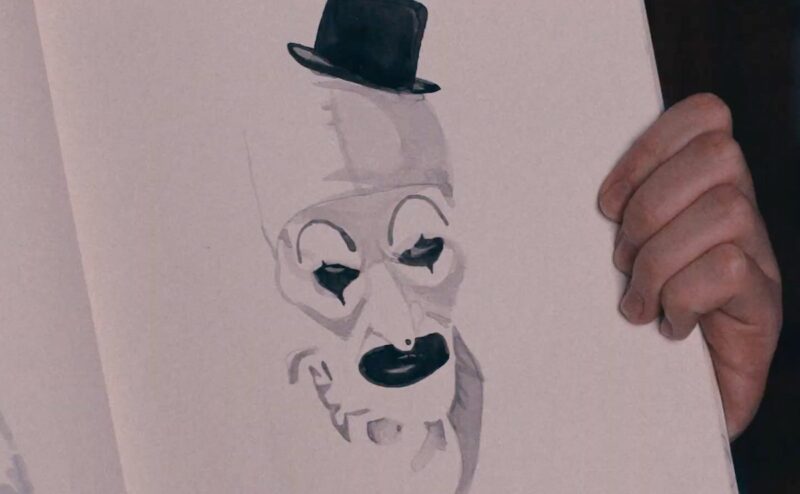
The sword
Sienna’s sword is key for understanding so much about Terrifier 2. First, it’s an important part of the movie’s mythology and understanding the father’s role in the story. Sienna’s late father created the sword in an effort to equip his daughter with the power to vanquish Art the Clown. Thus, the sword becomes a symbol of overcoming grief, as Sienna must use her father’s weapon to defeat the evil entity that drove her father to suicide. Her hesitancy to accept this weapon is part of her journey to accept and eventually realize her destiny.
Torture
Art the Clown doesn’t just kill people—he absolutely tortures them. This is beyond torture porn. This entire motif advances the film’s core thematic exploration of grief in both the individual and communal sense. Art the Clown represents grief to Sienna, who lost her father, and generational trauma to all of Miles County, as the deaths of all his victims (in particular, Emily Crane, Art’s first victim) linger for years. The torture becomes an accentuation of that pain. Art the Clown beats his symbolic presence into his victims. He creates lifelong wounds in those who make it out alive and completely decimates the bodies of those who die (especially Sienna’s poor friend Allie).
Anxiety
While Terrifier 2 is very much a horror movie, much of the film is a family drama. The entire Shaw family—Barbara (who drinks and berates her children), Sienna (who suffers from panic attacks and insane visions), and Jonathan (who is obsessed with understanding his father’s drawings)—is clearly suffering as the result of their patriarch’s suicide. Thus, they lash out, constantly losing check of their emotions. This overwhelming anxiety doesn’t just plague them, but by anybody in Miles County affected by the brutal presence of Art the Clown.
Art
The power of art is an important theme in Terrifier 2, lending weight to the art created by Sienna and her father. Sienna is clearly inspired by her father’s art to create cool costumes, which beautifully allows his legacy and spirit to live on through her. But Sienna’s father also depicted terrifying visions through his art. This duality represents the yin and yang of the father’s ghostly presence: while his art gave a face to the clown that would torture Sienna and her family, his art also gave Sienna the power to defeat such evil. The angel warrior suit she draws and then brings to life becomes the perfect companion to the sword the father also drew and brought to life.
Questions & answers about Terrifier 2
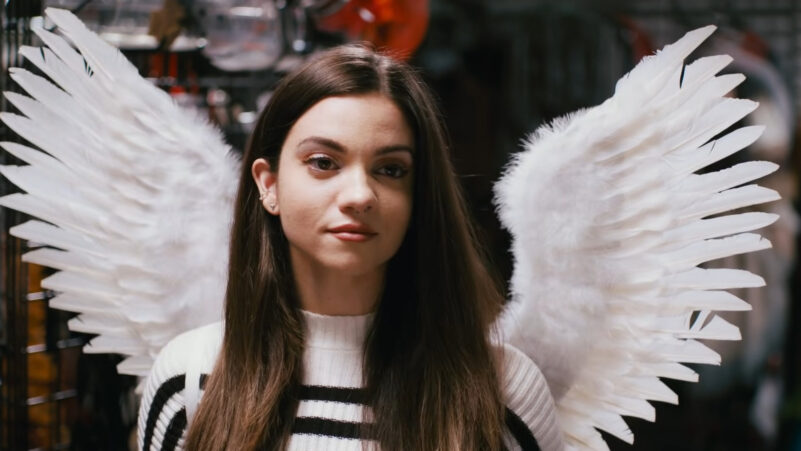
Is Art the Clown in Terrifier 2 the dad?
We answered this question in more detail in the ending explanation, but I’ll give a quick breakdown here. Damien Leone went into detail about the father’s presence in Terrifier 2 in the director’s commentary:
The father was sort of a vessel for that supernatural good that needs to get to Sienna, and he was the one who started getting the visions; not understanding why necessarily or what’s happening, but he knew he had to get the sword for Sienna. He knew that she was meant for something important. And because of that, he was also channeling the bad force that was coming in; the evil entity that was gonna be the counterpart to that good. It was all starting to come through, and that’s why he was becoming abusive. And all of this going on inside of him manifested itself into a physical tumor that eventually made him go crazy and kill himself. He was the vessel. It was channeling through him, and he was supplying Sienna with what she needed to go forward on her journey. It was an essential sacrifice on his part.
Essentially, the answer to this question is more complicated than “Sienna’s father is the clown” or “Sienna’s father isn’t the clown.” It’s more that Sienna’s father represents the clown. We know that her father saw Art in his visions and tried to warn his daughter about his presence. And we know these visions eventually drove him to his death. Leone’s quote signals that the very act of warning his daughter is what caused Art’s evil to infest the father and cause a brain tumor. And since grief is one of the movie’s most prominent themes, Art comes to represent the grief created by the father’s suicide.
In this way: yes, the father is the clown. But perhaps only in the symbolic sense.
What is the point of the Little Pale Girl?
As we discussed in the themes section, the Little Pale Girl symbolically represents the trauma that can grip a community. In the world of the Terrifier franchise, Little Pale Girl is actually Emily Crane, the daughter of circus performers who was Art the Clown’s first victim years ago in Miles County. Her death became a daunting mystery that people in the community obsessed over for years. So, the Little Pale Girl’s lingering presence serves as a constant reminder of the evil that exists in the shadows of Miles County. Even when you think he’s dead, the Little Pale Girl—the first victim that initiated Art the Clown’s reign of terror—will ensure he comes back for more.
Cast
- Damien Leone – Director, writer, editor, sound designer, special effects, visual effects, and Queen Phoeni
- Lauren LaVera – Sienna Shaw
- David Howard Thornton – Art the Clown
- Elliott Fullam – Jonathan Shaw
- Sarah Voigt – Barbara Shaw
- Amelie McLain – The Little Pale Girl / Emily Crane
- Kailey Hyman – Brooke
- Casey Hartnett – Allie
- Chris Jericho – Burke
- Leah Voysey – the Clown Cafe TV host, and a nurse
- Samantha Scaffidi – Victoria Heyes
- Charlie McElveen as Jeff
- Johnnath Davis – Ricky
- Amy Russ – Allie’s Mother
- Cory DuVal – Coroner

